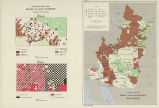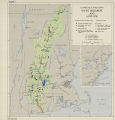| OCR Text |
ments dictate, these supplies should be developed to provide sufficient water sources for the economy of the basin. The protection and development of ground water supplies will require regulation in order to assure an adequate yield. In the Washington metropolitan area, provision must be made not only for the city of Washington itself, but also for many of the surrounding com- munities in Virginia and Maryland, which will lack adequate water supply sites. Pollution Abatement The pollution abatement element of a program for the basin should consider all beneficial water uses, such as public water supplies, propagation of fish and aquatic wildlife, recreational purposes, and agricultural, industrial, and other common uses. It should provide for degrees of treatment com- mensurate with uses and the type and quality of wastes in any specific areas. Control of mine wastes, industrial wastes, and silt or soils pollution should be considered along with treatment of municipal sewage in providing water of adequate quality to meet requirements of the inhabitants and industries of the basin. Recreation The Potomac Basin is tributary to the great population concentrations of the Washington- Baltimore metropolitan area. The unfulfilled recreation needs of these and adjacent population centers of the middle Atlantic coast are great. The Potomac Basin has extensive recreational potential. This must be planned to make its maximum con- tribution to fulfilling the needs of the region and the Nation. To do this, recreation development of the Potomac must be planned so as to take into consideration (1) the recreational needs of the metropolitan areas and national interest in the lower Potomac by virtue of its being an integral part of the National Capital; (2) its relationship to the great seashore and tidewater areas nearby; (3) preservation of the natural scenic, historic, and recreational features of dominant national or re- gional significance within the basin; and (4) use of all the recreation potentials of the basin-the moun- tains, the forests, the waters. The basin as a whole is well endowed with run- ning streams and wooded highlands. It is lacking, however, in natural fresh water lakes. An element in any comprehensive plan for the Potomac Basin would include the development of the natural reaches of the streams for more intensive use for fish- ing, boating, and swimming, as well as the design and operation of artificial reservoirs to serve recreational purposes consistent with their optimum multiple-purpose benefits. Many of the forested mountain areas are in public ownership-Federal and State. Elements of a plan would provide for greater use of national forests through better access and better facilities for visitors. Pollution will be abated. Fish and Wildlife Tidewater Potomac is an important area for both fish and wildlife. The Potomac fisheries have suffered from overexploitation and from pollution and turbidity. Proper sewage treatment and soil erosion control, which are important parts of the plan, will assist in preserving and rehabilitating the fishery resources of the lower river. Construction of dams on the river and the reduction of flood flows may serve to benefit the remaining oyster beds in the lower Potomac and adjacent parts of Chesapeake Bay by reducing the range of salinity, which may be as harmful to oyster beds as excessive deposits of sediment. Plans for reservoir operation will have consideration for this effect. The lower Potomac marsh lands are part of the Chesapeake Bay waterfowl area, one of the key wintering areas for waterfowl within the Atlantic Flyway. Drainage of these marshes threatens to reduce below the minimum the marsh areas re- quired for flyway purposes. The plan to preserve adequate waterfowl refuges also includes the eradi- cation of water chestnut in the lower river, which will preserve the vegetation on which the water- fowl depend, and provide incidental benefit to navigation. Fuller use of the upper part of the basin for fishing will follow upon the elimination of local areas of pollution and sedimentation, upon more adequate stocking programs by State and Federal hatcheries, improvement of the fish habitat, and often measures for full utilization of the artificial impoundments. Minerals Development Coal mining is a significant aspect of the economy in the westernmost part of the basin. Although under present competitive conditions mining activ- ity in this area is declining, improved mining 911610-51------41 619 |


























































































































































































































































































































































































































































































































































































































































































































































































































































